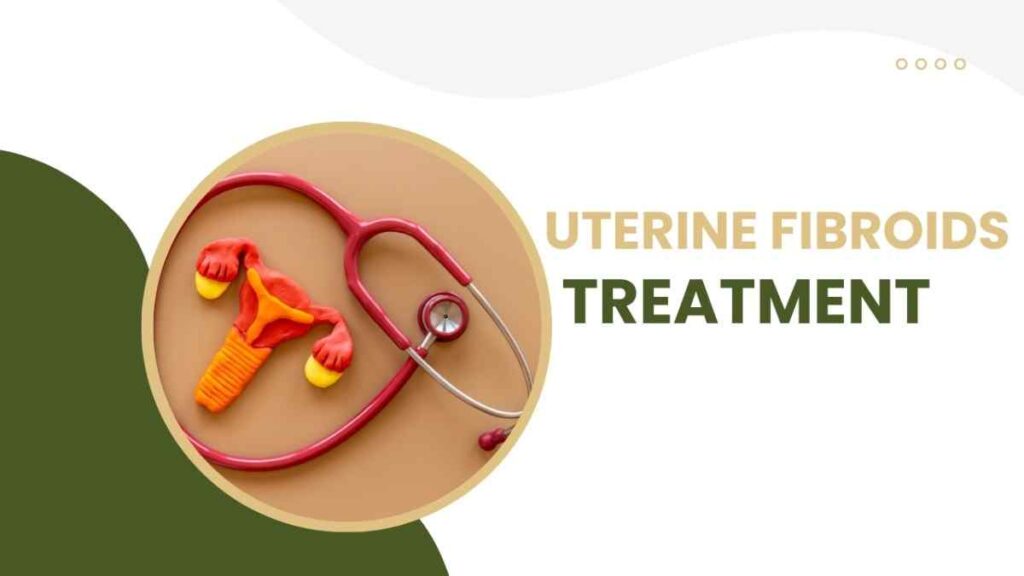Last updated on May 20th, 2025 at 12:07 pm

Uterine fibroids, non-cancerous growths in the uterus, are a common health concern for many women worldwide. These benign tumours can vary in size and number, causing symptoms like heavy menstrual bleeding, pelvic pain, and fertility issues. Fortunately, there are several effective treatment options available to address uterine fibroids and improve a woman’s quality of life.
These growths, also known as leiomyomas or myomas, develop from the smooth muscle tissue of the uterus. While the exact cause of fibroid formation is unclear, various factors like hormonal imbalances, genetics, and environmental influences may contribute to their development.
Uterine Fibroids Treatment Common Symptoms
Uterine fibroids can manifest with a range of symptoms, and their severity can vary from woman to woman. Common signs include:
- Menstrual Changes: Heavy and prolonged menstrual bleeding is a frequent symptom of uterine fibroids, leading to anaemia in some cases.
- Pelvic Pain and Pressure: Fibroids can cause discomfort and pressure in the pelvic region, often leading to lower back pain.
- Frequent Urination: Large fibroids may press against the bladder, causing a frequent urge to urinate.
- Painful Intercourse: Fibroids can interfere with sexual activity, causing pain or discomfort.
- Infertility or Pregnancy Complications: Fibroids may affect fertility and can lead to complications during pregnancy, such as a higher risk of cesarean section.

Uterine Fibroids Treatment
- Watchful Waiting: In some cases, especially if fibroids are small and asymptomatic, a “watchful waiting” approach may be recommended. Regular monitoring and lifestyle adjustments can be implemented to manage symptoms.
- Medications: Hormonal medications, such as birth control pills, may help regulate menstrual bleeding and alleviate symptoms. GnRH agonists can also be prescribed to shrink fibroids temporarily by suppressing estrogen and progesterone production.
> Consult a Doctor and Medkart will help you Order Medicines Online
- Minimally Invasive Procedures: For women seeking non-surgical options, procedures like uterine artery embolization (UAE) or myomectomy may be considered. UAE blocks blood flow to the fibroids, while myomectomy involves the surgical removal of individual fibroids.
- Endometrial Ablation: This procedure aims to destroy the uterine lining, reducing menstrual bleeding. While it doesn’t remove fibroids, it can provide relief from heavy periods.
- Hysterectomy: In cases where fibroids are large, causing severe symptoms, or when fertility is not a concern, a hysterectomy (removal of the uterus) may be recommended as a definitive solution.
Subserosal Uterine Fibroid Treatment
Subserosal uterine fibroids are a type of fibroid that grows on the outer surface of the uterus. Unlike fibroids located within the uterine wall (intramural) or those protruding into the uterine cavity (submucosal), subserosal fibroids extend outward. Treatment options for subserosal uterine fibroids depend on factors such as the size of the fibroid, the severity of symptoms, and a woman’s reproductive goals.
In many cases, watchful waiting may be considered if the fibroid is small and asymptomatic. However, if symptoms such as pelvic pain, pressure, or fertility issues arise, various interventions can be explored. Minimally invasive procedures, such as laparoscopic or robotic myomectomy, are common approaches for removing subserosal fibroids while preserving the uterus.
For women who have completed their family planning or when the fibroids are huge or causing severe symptoms, a hysterectomy may be recommended as a definitive solution. Consulting with a healthcare provider is crucial to determine the most appropriate treatment strategy tailored to the woman’s individual needs.
Also, Read:
- How to Increase Breast Size?
- Maximum Delay in Periods if not Pregnant
- Maximum How Many Days to confirm Pregnancy?
Uterine Fibroid Treatment In Ayurveda
In Ayurveda, the traditional system of medicine rooted in ancient Indian philosophy, the treatment of uterine fibroids involves a holistic approach focusing on balancing the doshas (bioenergetic forces) and addressing the root cause. Ayurvedic treatments for uterine fibroids often include herbal formulations, dietary modifications, and lifestyle practices.
Herbs like Ashoka, Lodhra, and Shatavari are commonly prescribed to regulate hormonal imbalances and reduce inflammation. Additionally, detoxification therapies such as Panchakarma may be recommended to eliminate toxins from the body. Ayurvedic practitioners emphasize personalized treatment plans tailored to an individual’s constitution, aiming to restore overall health and promote well-being while addressing the specific symptoms associated with uterine fibroids. It’s crucial for individuals considering Ayurvedic treatments to consult with qualified practitioners for a comprehensive and personalized approach.
Empowering Women Through Education
Knowledge is a powerful tool for women facing uterine fibroids. Understanding the available treatment options, their risks, and benefits empowers individuals to make informed decisions about their health. Women must consult healthcare professionals to determine the most suitable treatment plan based on their unique circumstances and goals.

Conclusion
Uterine fibroids can significantly impact a woman’s quality of life, but there are various effective treatment options available. By staying informed, seeking medical advice, and actively participating in the decision-making process, women can navigate the journey of uterine fibroid treatment with confidence. Remember, each woman’s experience is unique, and the most appropriate approach will depend on individual factors, including symptoms, age, and future family planning goals.
Read: What are Generic Medicines?
FAQs on Uterine Fibroids Treatment
Q1. What is Uterine fibroid treatment?
Uterine fibroids treatment includes non-surgical options such as medications to manage symptoms, while minimally invasive procedures like myomectomy or uterine artery embolization can selectively remove or shrink fibroids. In severe cases or for those not considering future pregnancies, a hysterectomy may be recommended as a definitive solution.
Q2. Can uterine fibroids be treated without surgery?
Yes, non-surgical treatments for uterine fibroids include medications, such as hormonal therapy, and minimally invasive procedures like uterine artery embolization or endometrial ablation.
Q3. Will treating uterine fibroids affect my fertility?
It depends on the treatment. Minimally invasive procedures like myomectomy can preserve fertility by removing fibroids, while some medications may impact fertility temporarily.
Q4. Is a hysterectomy the only solution for severe uterine fibroids?
No, a hysterectomy (removal of the uterus) is one option, but less invasive procedures like myomectomy or uterine artery embolization can also be considered based on the severity of symptoms and a woman’s reproductive goals.